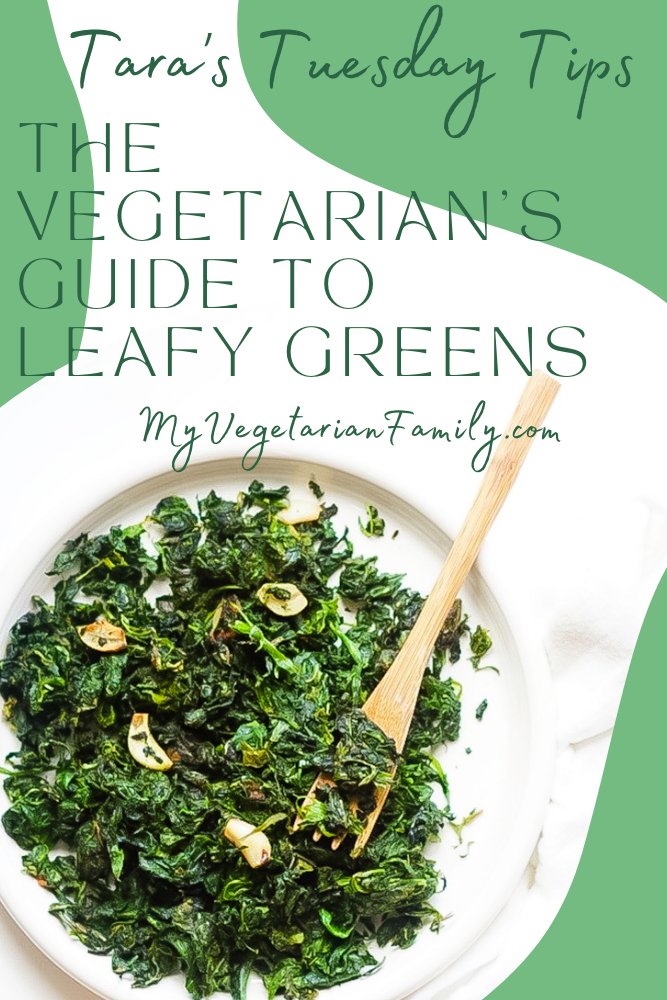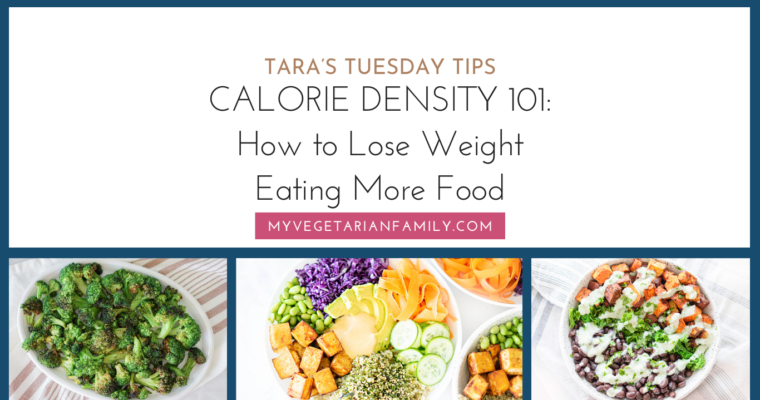Do you eat greens simply because you have to? What compels you to eat greens? With so many different types of leafy greens available, it can get really confusing! Which ones are better raw versus cooked, how to wash them, store them, and prepare them. The Vegetarian’s Guide To Leafy Greens will sort through the green, give you a few health facts + help you actually enjoy eating your greens!
Tara’s Tuesday Tips:
The Vegetarian’s Guide To Leafy Greens
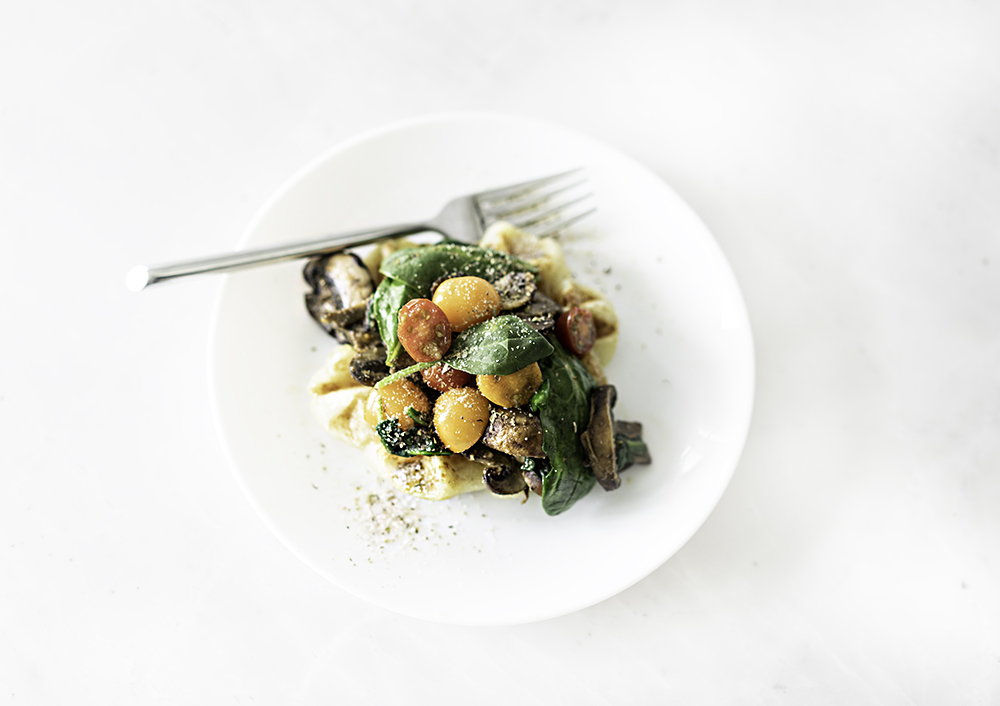
10 Reasons To Eat Your Greens
I go into LOTS of detail about why eating green is essential to our health in my article, Why You Should Be Eating Green. Below are my top 10 reasons why you should be getting a daily dose of leafy greens.
1. Phytochemicals
Green vegetables are actually plants. We can thank phytochemicals for the vibrant green color and a whole host of health benefits.
2. Phytates
Dark green vegetables also contain phytates which gives greens their cancer-fighting properties.
3. Antioxidants
Antioxidants fight off free radicals – the pesky molecules that damage our body tissues increasing our risk of developing cancer and lots of other illnesses. Greens are super high in antioxidants.
4. Fiber
Green fruits + vegetables have lots and lots and lots and lots of fiber! Fiber helps our bodies produce good gut bacteria which keeps our weight in check, prevents constipation, fights off colon cancer, and stabilizes our mood. I can’t say enough good things about eating lots and lots and lots of green foods with lots and lots and lots of fiber. Get it?
5. Phytonutrients
As I outlined in my article, Mood Boosting Foods, eating more green vegetables can cut your odds of developing depression by 62%! That’s a lot! That is thanks to phytonutrients!
6. Immunity
Eating green foods can strengthen our immune system and help our bodies put up a stronger fight against those pesky pathogens that make us sick. I go into lots more detail about this in my article, Immunity Boosting Foods.
7. Calorie Density
Foods with more bulk (water and fiber) allow you to take in less calories while eating a larger volume of food. You can eat LOTS of green foods that are packed with fiber and make you feel full while keeping your blood sugar down and calorie count down. Read on about calorie density here.
8. Lutein
AKA the “eye vitamin”. Greens are super high in lutein! This wonder vitamin has been found to slow the progression of macular degeneration and lower your risk of cataracts.
9. Healthy Bones
High in Vitamin K + Folate, greens give you a double benefit for keeping your bones healthy + giving them the nutrients they need to grow and repair themselves.
10. Diabetes Prevention/Treatment
Multiple studies have been published documenting the results of placing diabetics on a plant-based diet high in greens. More greens = better blood sugar control, less insulin consumption, improved A1c levels, weight loss, and even less diabetic complications. Lots more information on this in my article, How To Eat To Prevent Diabetes.
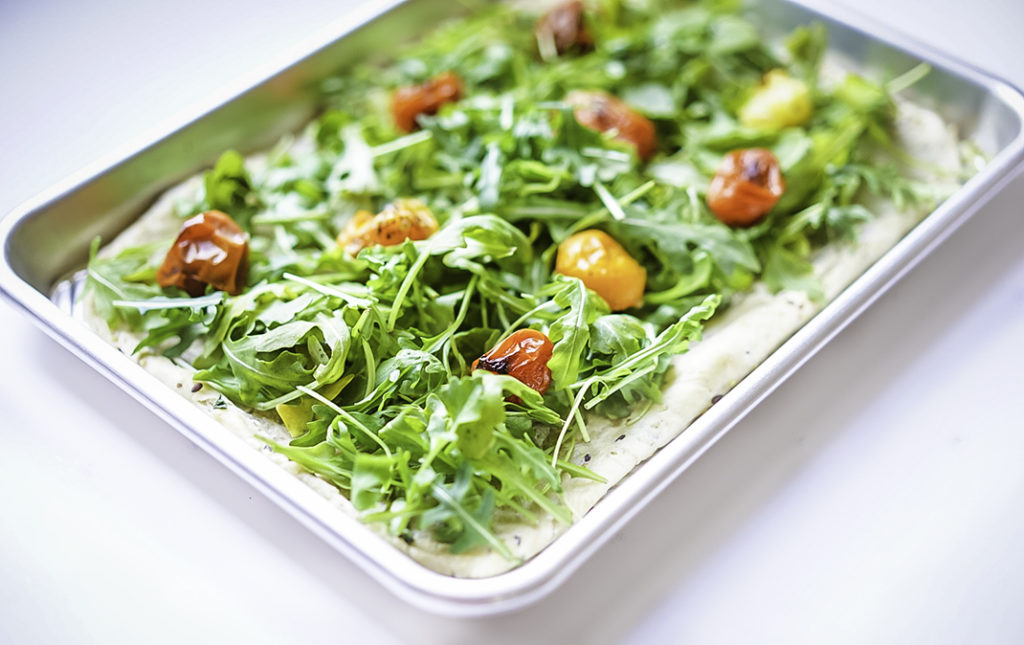
Which Of The Leafy Greens Are The Most Nutritious?
The green nutrient powerhouses include spinach, kale, romaine, watercress, and arugula as they are the highest in Vitamins A, C, K, folate, and potassium.
And The Least Nutritious Leafy Greens?
Sorry to all of my iceberg lettuce salad lovers. The least nutritious leafy green is iceberg lettuce. If you just can’t live without good old iceberg lettuce, simply mix it in with other leafy greens and you will be all set!
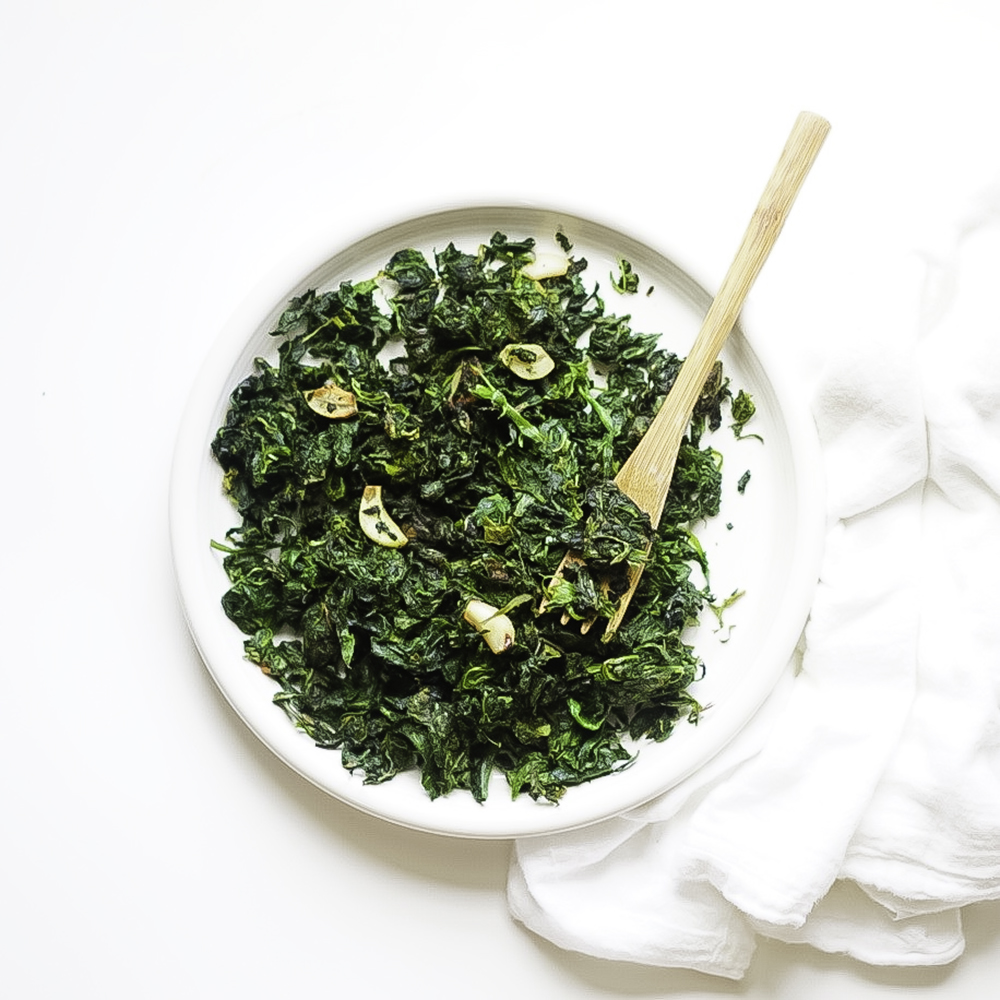
Washing Leafy Greens
When you first get leafy greens home from the farmer’s market or grocery store, they need to be washed well. First, remove any outer leaves that may be damaged and the core of lettuce heads. Second, separate the leaves. Then, run each leaf under cool running water, drain excess water in a colander or salad spinner. Place on a clean towel to dry.
Storing Leafy Greens
These green beauties are best used within the first few days of washing. However, if you buy + wash them in advance, the trick to preventing them from wilting is to allow them to dry thoroughly or pat dry with a clean towel. Then, place them in a storage bag (Ziploc or other) wrapped in a clean towel to absorb any leftover moisture. Store in your refrigerator (preferably in the vegetable drawer) away from any fruits that will give off ethane gas an hasten the spoiling process. Kale or collard greens or any of your leafy greens with a hearty stem can be stored in a glass jar with water in the refrigerator (like flowers in a vase).
How To Make Leafy Greens Taste Better
With all of the nutrients in greens, they tend to have a very strong flavor. From bold to bitter, and spicy to peppery, greens have an extremely robust flavor profile. Wait, don’t give up on greens! Here are a few tips to make them more palatable:
- Lightly steam them to soften them up just a little before using.
- Eat more! The more you eat them, the more of a tolerance to the flavors you will gain.
- Drizzle them with something acidic to reduce the bitterness (lemon, lime, or vinegar).
- Sprinkle with salt to make them easier to chew.
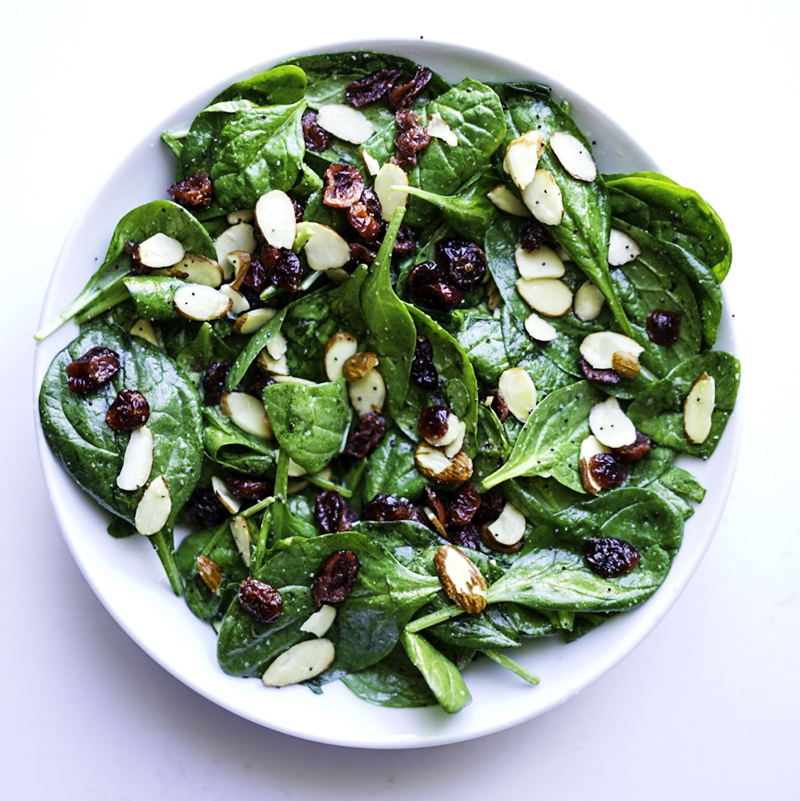
The Vegetarian’s Guide To Leafy Greens:
The Green List
Spinach
Taste: mild, neutral, kid-friendly
Use: pizza topping, soup, salad, smoothies, high in folate
Kitchen Tip: wilts easily, avoid high heat, don’t overcook as you will lose the nutrients + flavor
Kale
Taste: bitter, fibrous
Use: juicing, smoothies, kale chips, salad
Kitchen Tip: before eating, massage kale leaves with lemon or olive oil as this helps remove some of the bitterness and tough texture. Baby kale has a milder flavor for salads.
Collard Greens
Taste: bitter
Use: wraps, stews, sauté
Kitchen Tip: cook long + slow, VERY high in vitamin K. Bitter taste fades away the longer it cooks.
Swiss Chard
Taste: not as bitter as kale, not as mild as spinach, crisp + slightly sweet
Use: salad, soup, stir-fry, smoothie
Kitchen Tip: aka rainbow chard + adds a pretty color to salads, chop the stems + sautée with garlic.
Dandelion Greens
Taste: bitter + peppery
Use: salads, sandwich topping, sauté or steam
Kitchen Tip: many people use for detox or cleanse. Brew a few leaves with tea or eat raw.
Mustard Greens
Taste: bitter + spicy, most spicy of all the leafy greens, rich mustard flavor
Use: salad, soup, stir-fry
Kitchen Tip: cook them + they will taste better – takes the bitterness away!
Arugula
Taste: peppery
Use: salad, pizza topping, as a lettuce replacement in sandwiches or wraps, pesto
Kitchen Tip: choose baby arugula as it has a less robust flavor but wilts quicker so use within the first few days of purchasing.
Watercress
Taste: peppery
Use: salad, soup, smoothies
Kitchen Tip: eat this one raw! Perfect mixed with other greens in a salad.
Bok Choy
Taste: tender, mild + sweet
Use: stir-fry, saute, steam
Kitchen Tip: no waste! 100% edible! Very high in selenium. Baby bok choy is smaller + cooks quick.
Easy Recipes To Green Up Your Plate:
Sautéed Frozen Spinach
Kale Gnocchi with Spinach Avocado Sauce
Spinach Florentine Bagel Copycat Einstein Bros
Broccoli Sprout Pesto (Oil-Free)
Thai Salad With Peanut Dressing
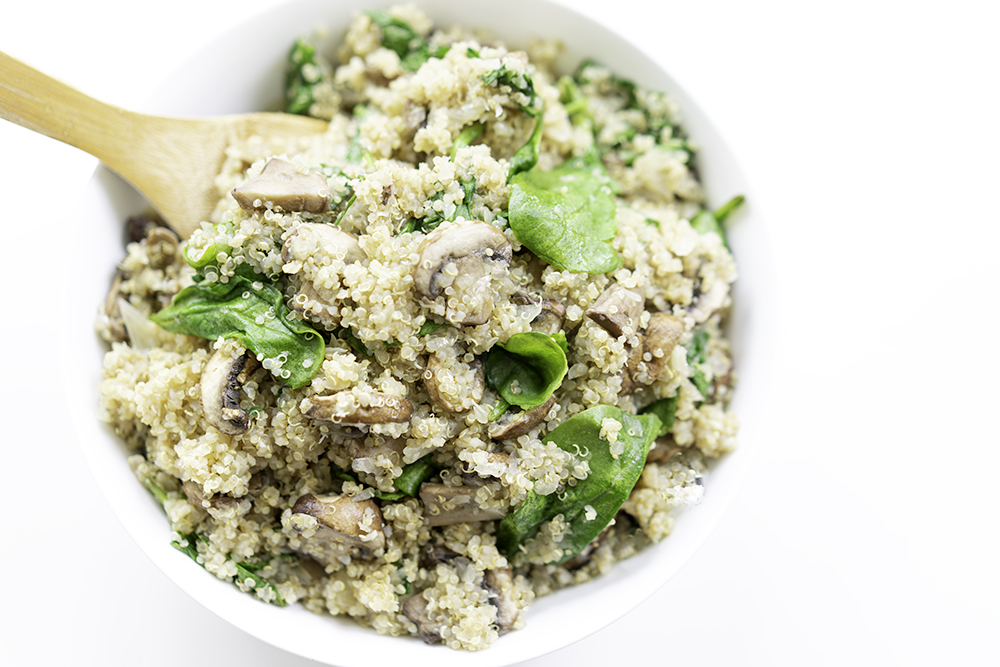
Food For Thought
Green foods are packed with phytonutrients, antioxidants, and have amazing healing properties! They are also high in fiber, low in sugar, low in calorie density, and loaded with lots of vitamins. Not sure which one you will like? Try it + try it again! Remember, some of these foods you need to build up a taste tolerance to. If at first you don’t like the robust flavor, wait a few weeks + try again, you will be surprised! It works!
It’s not easy being green … or is it? 🤔
All the best
Tara 💚
⭐ Feeling inspired by The Vegetarian’s Guide To Leafy Greens? Leave a comment below, I love to hear from you!⭐
📸I love to see your creations! Follow me on Instagram @myvegetarianfamily and hashtag it #myvegetarianfamily
💌Be sure to subscribe here to my weekly emails for tips and recipes so that you never miss a veggie thing!
